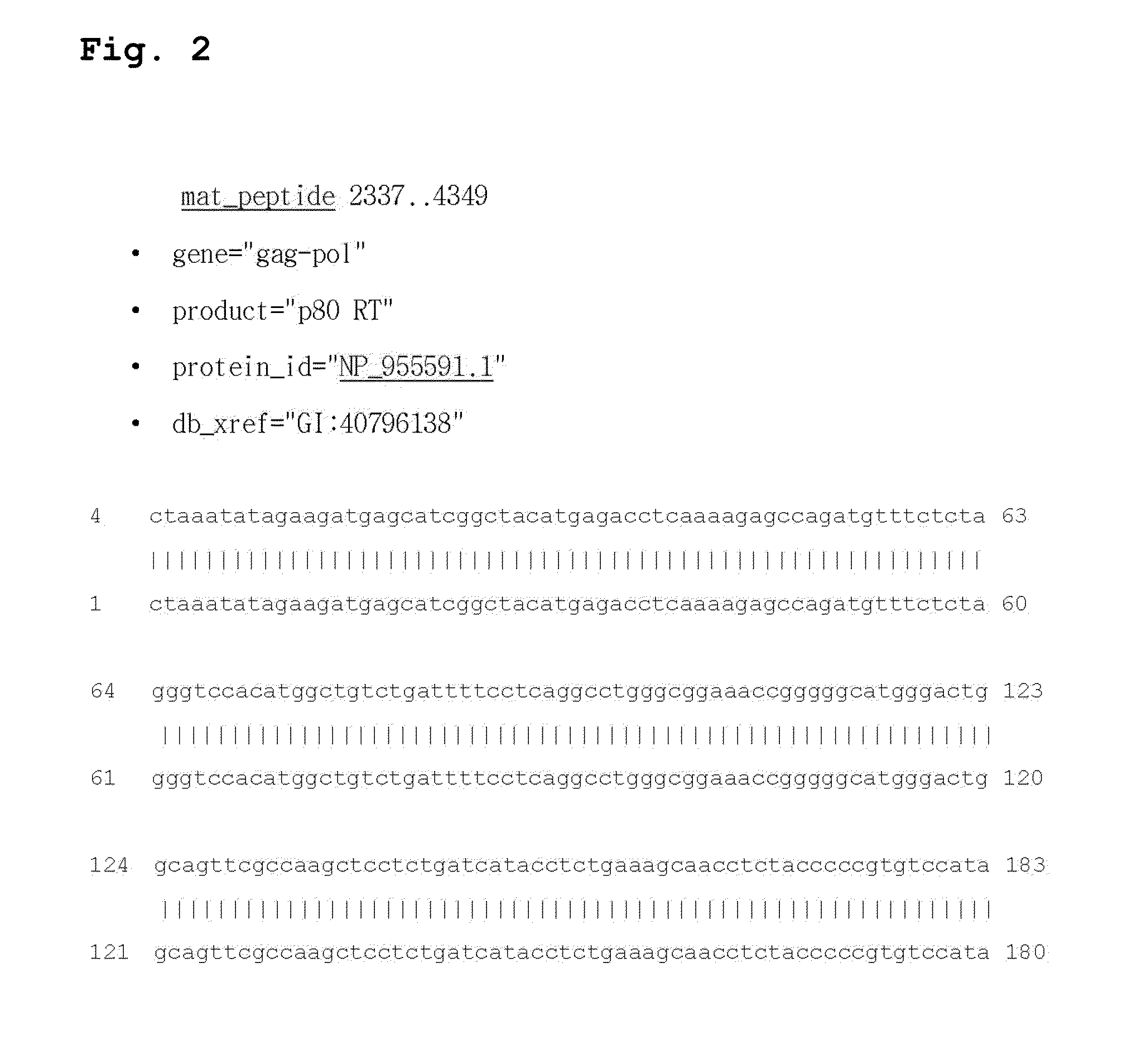Reverse transcriptase having improved thermostability
- Summary
- Abstract
- Description
- Claims
- Application Information
AI Technical Summary
Benefits of technology
Problems solved by technology
Method used
Image
Examples
example 2
[0051]The 8 mutant reverse transcriptase genes constructed in Example 1 were cloned by using the extranuclear gens PET 22b(+) (NOVAGEN CO.) as an recombination vector. To do so, PCR was performed with the mutant genes (Q63L, K264L, T306L, and E346M) synthesized by being introduced in pGEM-T easy vector (Promega) using the following primer set.
Sense strand:(SEQ. ID. NO: 168)5′-GCG CGC CAT ATG CTG AAC ATC GAA GACGAA CAC CGT CTG CAC GAA AC-3′ (Nde I)Antisense strand:(SEQ. ID. NO: 169)5′-GCG CGC GCG GCC GCT TAG ATC AGCAGG GTA GAG GTG TCC GGG GTT TC-3′ (Not I)
[0052]PCR was also performed with other mutant genes (K295Q, P408E, H438Y, and N454Y) using the following primer set.
Sense strand:(SEQ. ID. NO: 170)5′-GCG CGC CAT ATG CTG AAC ATC GAA GACGAA CAC CGT CTG CAC GAA AC-3′ (Nde I) Antisense strand:(SEQ. ID. NO: 171)5′-GCG CGC GCG GCC GCG ATC AGC AGGGTA GAG GTG TCC GGG GTT TC-3′ (Not I)
[0053]The extranuclear gene vector PET 22b(+) and each M-MLV reverse transcript...
example 3
Expression of Mutant Reverse Transcriptase
[0055]Single colony of the expression strain prepared by transforming BL21(DE3) host cells was taken and transferred in 15 ml of LB (Luria-Bertani) medium containing ampicillin (50 mg / ml), followed by culture at 37° C. for overnight. As a result, seed cells were obtained. The obtained seed cells were placed in 1 l of LB medium containing ampicillin, followed by culture at 37° C. for 2 hours, to which 0.5 mM IPTG (isopropyl β-D-1-thiogalactopyranoside) was added. Expression was induced for 2 more hours. The cultured cells were centrifuged and as a result pellet was obtained. The pellet was stored at −50° C. until the pellet was purified.
example 4
Purification of Mutant Reverse Transcriptase
[0056]5 g of the frozen cell pellet obtained in Example 3 was pulverized, followed by suspension in lysis buffer (25 mM Tris-HCl (pH 7.6), 1 mM EDTA, 10% (v / v) β-mercaptoethanol, and phenylmethylsulfonyl fluoride (PMSF) 20 ml) for 30 minutes with stirring at 4° C. Then, the cells were lysed by using Fisher sonicator. The cell lysate was centrifuged at 11,000 rpm for 1 hour at 4° C., and pellet was discarded. The remaining clear lysate was dialyzed in a buffer (40 mM Tris-HCl (pH 7.6), 2 mM EDTA, 28.58 mM β-mercaptoethanol, and 100 mM KCl).
PUM
| Property | Measurement | Unit |
|---|---|---|
| Temperature | aaaaa | aaaaa |
| Length | aaaaa | aaaaa |
| Temperature | aaaaa | aaaaa |
Abstract
Description
Claims
Application Information
 Login to View More
Login to View More - R&D
- Intellectual Property
- Life Sciences
- Materials
- Tech Scout
- Unparalleled Data Quality
- Higher Quality Content
- 60% Fewer Hallucinations
Browse by: Latest US Patents, China's latest patents, Technical Efficacy Thesaurus, Application Domain, Technology Topic, Popular Technical Reports.
© 2025 PatSnap. All rights reserved.Legal|Privacy policy|Modern Slavery Act Transparency Statement|Sitemap|About US| Contact US: help@patsnap.com



